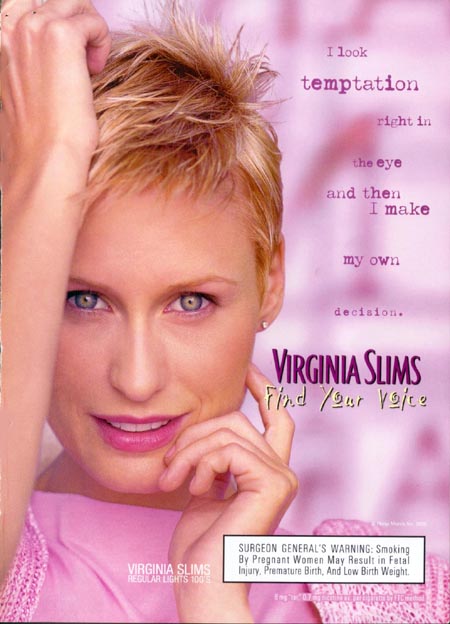 Brita Marie Wanger
Brita Marie Wanger
Soc 43: Survey of Mass Communication
Semiotics in Advertising paper
March 29, 2000
While some cigarette advertisements, like those for Marlboro, have their own distinctive looks, this one for Virginia Slims really blends in with its women's magazine counterparts. At first glance, this ad could be for just about anything sold to women: makeup, perfume, jewelry, or beauty aids. It is only in looking closer and reading the advertising copy that you realize that it is an ad for cigarettes.
The copy itself really blends in to the background, so it is not the first thing that you notice. Instead, you look first at the woman's face or at the 'Virginia Slims' logo. When you finally do read the copy, it offers only a vague statement which, purposefully, can be interpreted many ways. Using the "I" implies a speaker, but there is not a clear definition of who that speaker is. This makes it possible for the viewer to "adopt" the message as his or her own.
The basic [suggestion] of the message is that the speaker has strong will power and is not swayed by temptation. It is, of course, more complicated than that because even the phrase "look temptation right in the eye" has a separate denotation and connotation, but it is not particularly fruitful to explore them for the purpose of this analysis. The copy really has several possible connotative meanings. It can simply be talking about making decisions about what cigarette to smoke, or it can be talking about the decision of whether or not to smoke at all. Since neither of these things are clearly defined as the "temptation'' or the "decision," however, it connotes that the woman in question applies this tactic to other areas of life. You could easily substitute sex, food, money, or a number of other things for cigarettes and the statement would still be equally applicable. The copy, therefore, in its vague nature connotes a broad, pseudofeminist lifestyle approach. By using the concept of making "choices," it is even hinting, albeit very carefully, at broader political issues.
The catch slogan "find your voice" then reinforces this in an equally vague manner. Taken by its literal denotation, the phrase is actually absurd and ironic when a product is being sold which could cause one to lose one's voice temporarily or permanently. This particular phrase has, however, taken on a whole set of connotated meanings. It has become part of the myth of the empowered member of an oppressed group. It also plays on the ideology of the American Dream.  You could, in fact, imagine the same slogan printed in big red, white, and blue letters in a campaign ad. Here, however, it is printed in yellow, which symbolically denotes fear and timidity, and in a swirly paintbrush type, which is a sign of playfulness. In this way, the straightforward message of what is being said is contradicted by something as seemingly innocent as the typeface.
You could, in fact, imagine the same slogan printed in big red, white, and blue letters in a campaign ad. Here, however, it is printed in yellow, which symbolically denotes fear and timidity, and in a swirly paintbrush type, which is a sign of playfulness. In this way, the straightforward message of what is being said is contradicted by something as seemingly innocent as the typeface.
The message, of course is even further contradicted by the visual imagery which, as I mentioned before, is what you notice first. First of all, the ad itself is overwhelmingly pink. Not only are the model's clothing and makeup pink, but the studio background as well. Even the model's fingernails are pink. The color in itself is meaningless, but in our cultural context it is a very big part of the cultural code of "femininity." It therefore functions as a symbol for all of traits of our culture's traditional female ideal, like innocence, cleanliness, and sexual purity. Therefore, in contradiction to the message we are being given in the text, which suggests behavior, that is not part of the old myth of the ideal female, we are overwhelmed by a color that, in its cultural connotation, represents traditional female roles.
There are more subtle details in the way that the model herself is presented that further add to the contradictory nature of the message. Like in most advertising directed at women, there is an implied "male gaze." She is in fact looking this implied man "right in the eye," a gesture which is symbolic of equality and reciprocity, but the is also covering parts of her face, opening her mouth, and her head is actually tilted downward while her eyes are looking up.  This is a very childlike pose, and it would be difficult to take any man or woman seriously if they were looking at you this way in real life. This meek posturing implies a meek and playful attitude which is obviously being directed toward a male eye, which may imply that the woman is making her "own decision," but that she is using her sexuality as power rather than making an attempt at autonomy.
This is a very childlike pose, and it would be difficult to take any man or woman seriously if they were looking at you this way in real life. This meek posturing implies a meek and playful attitude which is obviously being directed toward a male eye, which may imply that the woman is making her "own decision," but that she is using her sexuality as power rather than making an attempt at autonomy.
The model's short cropped haircut may be seen as, in itself a symbol of female autonomy, because it implies that she has shorn what is often considered a burden women carry for men. The "decision" could even be construed, in this ad, to refer to the decision to cut her hair, but the fact that she is behaving in such a meek way and, in fact, playing with her hair does not reinforce the message that she is proud of this statement as anything more than fashion. The ad goes to great lengths to make up for this one symbol of non-traditional female appearance.
One tiny detail which, once noticed, becomes the ultimate contradiction to any message of independence is the model's diamond earring. While it can be expected that the woman has chosen her own outfit and hairstyle, diamond earrings are a part of the "romance myth," and while she wears no engagement ring or wedding band, we are led to assume that she does have a boyfriend who has given her these earrings. Diamond earrings are, in our culture, a part of the romance story, which traditionally leads to marriage.
Diamond earrings are, in our culture, a part of the romance story, which traditionally leads to marriage.
The ad leads us to believe, therefore, that Virginia Slims cigarettes can also be a part of this story of a "superwoman" who is at once autonomous and ultra-feminine despite all of the inherent contradictions. Much like the earlier ["You've come a long way, baby!"] Virginia Slims ad we viewed in class, there is the confusing suggestion that smoking these cigarettes is a statement of female independence which does not require that you give up "pretty" clothes, makeup, or even extravagant gifts from a male admirer. They are offering a possible female identity, albeit an impossible one.
 You could, in fact, imagine the same slogan printed in big red, white, and blue letters in a campaign ad. Here, however, it is printed in yellow, which symbolically denotes fear and timidity, and in a swirly paintbrush type, which is a sign of playfulness. In this way, the straightforward message of what is being said is contradicted by something as seemingly innocent as the typeface.
You could, in fact, imagine the same slogan printed in big red, white, and blue letters in a campaign ad. Here, however, it is printed in yellow, which symbolically denotes fear and timidity, and in a swirly paintbrush type, which is a sign of playfulness. In this way, the straightforward message of what is being said is contradicted by something as seemingly innocent as the typeface. Brita Marie Wanger
Brita Marie Wanger This is a very childlike pose, and it would be difficult to take any man or woman seriously if they were looking at you this way in real life. This meek posturing implies a meek and playful attitude which is obviously being directed toward a male eye, which may imply that the woman is making her "own decision," but that she is using her sexuality as power rather than making an attempt at autonomy.
This is a very childlike pose, and it would be difficult to take any man or woman seriously if they were looking at you this way in real life. This meek posturing implies a meek and playful attitude which is obviously being directed toward a male eye, which may imply that the woman is making her "own decision," but that she is using her sexuality as power rather than making an attempt at autonomy. Diamond earrings are, in our culture, a part of the romance story, which traditionally leads to marriage.
Diamond earrings are, in our culture, a part of the romance story, which traditionally leads to marriage.